Do you have outdoor work or recreation planned for this summer? I’ve got some information about portable generators that you’ll want to read. At the end of this article you’ll also be able to enter a contest to win your own generator for outdoor living. Entry is FREE and you can enter as many times as you like.
I bought my first generator in 1988 to help with outdoor building away from the grid. It was a top-of-the-line model, and as I gear up for more than the usual amount of outdoor time with a generator this coming summer 2021, I’m reminded of how generators have gotten so much better. This is especially true with what I call “generators for outdoor living”. Various models are more refined, more efficient and more versatile in specific ways, making them easier to live with outside. Read on to learn about technical details that’ll help you choose a generator that’s easier to live with while camping in a trailer park, as part of RV road trips, or while enjoying outdoor gatherings. And be sure to enter the contest giveaway at the end of this article for a chance to win one of two generators for outdoor living. When I compare the generator I’ll be using this summer to the first one I bought back in ’88, five main improvements come to mind:
Jump to the generator giveaway
Portable Generators Are 6x Cheaper Than They Used to Be
Yes, 6 times cheaper! Here’s what I mean: I paid $3500 for a top of the line 3500 watt generator in 1988, the first I ever bought. Adjusted for inflation, this equates to a whopping $6945 for a 3500 watt model. By contrast, the portable generator I’ll be using this summer has a peak power output of 4000 watts, it runs quieter than my first one and the power output is higher quality. All this yet it costs only $1000 in current money. That’s less than 15% of what I paid for that first generator, a model that was inferior in several ways to many models available today.
Portable “Inverter” Generators Make Pure Power

More pure power is something that modern generators deliver across the board, but power purity is especially good with some models called inverters. If you plugged any kind of sensitive electronics into that first generator I bought, strange humming and clicking noises would be heard. That’s because the power is what you call “dirty”. Audio electronics was the most prone to trouble. This is because the power put out by generators back then was often full of spikes, surges and poor wave forms. Not only did this cause poor performance in sensitive electronics, but would actually fry a stereo or computer. And while not all generators today put out truly pure power, the best models for outdoor living do. Look for models with a total harmonic distortion (THD) of less than 3%. Better yet, consider something officially called an “inverter” generator. These produce electricity in a different way than conventional generators, a way that leads to much greater power purity. Got a phone to charge or an electric trolling battery to top up before heading out on the lake? Generators for outdoor living are designed to provide 12 volts DC in addition to the usual 120 volts AC. Inverters also offer one other feature that greatly reduces fuel consumption, as you’ll see next.
Most Efficiency From Variable Engine Speed
Why have the engine on a generator running full blast all the time when you might need, say, only 20% of potential electrical power output at any given moment? The second advantage of inverters is their ability to vary engine speed depending on the electrical load demanded. Here’s what I mean: If all you need is 1000 watts from a 4000 watt inverter, the engine will run at roughly 25% of its maximum throttle, burning much less fuel and making considerably less noise. It’s easy to like an inverter.
Portable Generators Have Gotten Quieter
At least some models have. The less noise the better when it comes to any generator I’ll be standing near, and some current models are unbelievably quiet compared to what was commonly available even just 10 years ago. As you shop, look for published noise output figures on the models you’re considering. Decibels (dBA) are the units used to measure noise, and the quietest operation comes from so-called “inverter” generators. You can expect these to put out 53 dBA to 55dBA. That’s quiet enough for use in a camp ground or trailer park. Anything much over 60 dBA is likely to be too loud for comfortable outdoor living activities. If you can’t find noise output ratings on a particular model, don’t buy it. What’s the point in paying for a generator that’s too loud to be enjoyable? Why take the chance?
Portable Generators Are Easier to Transport

That first generator I bought weighed 50% more than many of comparable output today, and it had no wheels. And while the no-wheel thing was universal back then, today’s best models come with simple wheels and handles that add no significant weight yet boost mobility a lot.
Win a Generator & Watch a Video
To make the whole generator thing more interesting, I’ve arranged to give away two brand new generators. Click here to enter as many times as you like. Contest ends May 15, 2021, with winners announced in June. If you win, a brand new generator will be shipped to you at no charge. Enjoy!
Watch the video below for a more detailed tour of generators for outdoor living.



